Overview
The article titled "10 Essential Insights for Autism Special Education Success" offers vital strategies and insights aimed at enhancing the effectiveness of special education for children with autism. It highlights the crucial role of collaboration among parents, educators, and specialists, fostering a supportive environment. Additionally, the article underscores the necessity of individualized educational plans and early intervention, backed by evidence that demonstrates improved outcomes through these practices. This nurturing approach not only addresses the challenges faced by families but also encourages a proactive stance in seeking support and resources.
Introduction
Understanding the complexities of autism special education is essential for creating an inclusive and supportive learning environment. This article explores ten key insights designed to empower parents, educators, and caregivers as they navigate the challenges and opportunities within autism education. By examining effective strategies, the importance of early diagnosis, and the value of collaboration, readers will uncover ways to enhance educational outcomes for children with autism.
How might these insights reshape the educational landscape for families and educators, ensuring that every child has the opportunity to reach their full potential?
About ASD Media: Empowering Parents with Resources for Autism Education
At ASD Media, we are deeply committed to enhancing the implementation of Applied Behavior Analysis (ABA) therapy. Our goal is to provide valuable insights and strategies that help overcome challenges and improve outcomes for children and their families. We offer a diverse array of resources tailored for caregivers and specialists in the developmental support sector. By fostering a supportive and inclusive community, we encourage individuals to share their experiences, learn from one another, and receive essential support throughout their journeys.
Subscribing to our newsletter ensures you have access to the latest updates and unlimited online resources, empowering guardians and professionals to unlock the potential of children with ADHD. We focus on effective strategies for managing challenging behaviors, navigating support services, and enhancing social skills development.
Research indicates that community support significantly influences outcomes in autism special education. Collaborative efforts lead to better access to resources and services. For example, 76% of patients had multiple goals trending upwards after implementing a hybrid ABA treatment model, showcasing the effectiveness of community-driven initiatives. ASD Media plays a crucial role in this environment, offering expert insights and advice on best practices for parents navigating the complexities of autism special education related to developmental disorders. Ralph Moller emphasizes, "Children who receive ABA therapy often experience significant improvements in their overall development and daily functioning." Our initiatives have effectively improved the application of ABA therapy, demonstrating our dedication to bettering the lives of children with developmental disorders and their families.
Moreover, assisting a person with a developmental disorder can cost around $60,000 annually during childhood. This highlights the importance of the resources we provide at ASD Media. We invite you to join our community, share your experiences, and access the support you need to navigate this journey together.
Understanding IEPs: Key Components and Benefits for Autism Support
Individualized Education Programs (IEPs) are specially crafted educational plans that cater to the unique needs of students with autism. These plans for autism special education include essential components such as measurable goals, tailored accommodations, and the necessary services to support each student's learning journey. It's heartening to see recent advancements in IEPs that emphasize the importance of collaboration among educators, guardians, and specialists. This teamwork is vital in establishing a comprehensive support system for our children.
The benefits of IEPs are truly significant. They not only ensure access to appropriate educational resources but also foster a sense of community among all stakeholders involved. With a structured framework in place, tracking progress becomes more manageable and transparent. By understanding IEPs, you, as parents, are empowered to advocate effectively for your child's educational needs. This advocacy is crucial in paving the way for successful outcomes in both academic and social development.
As you navigate this journey, remember that you are not alone. Sharing your experiences and seeking support can make a world of difference. How have IEPs impacted your child's education? Your insights could inspire others and create a supportive dialogue in our community.
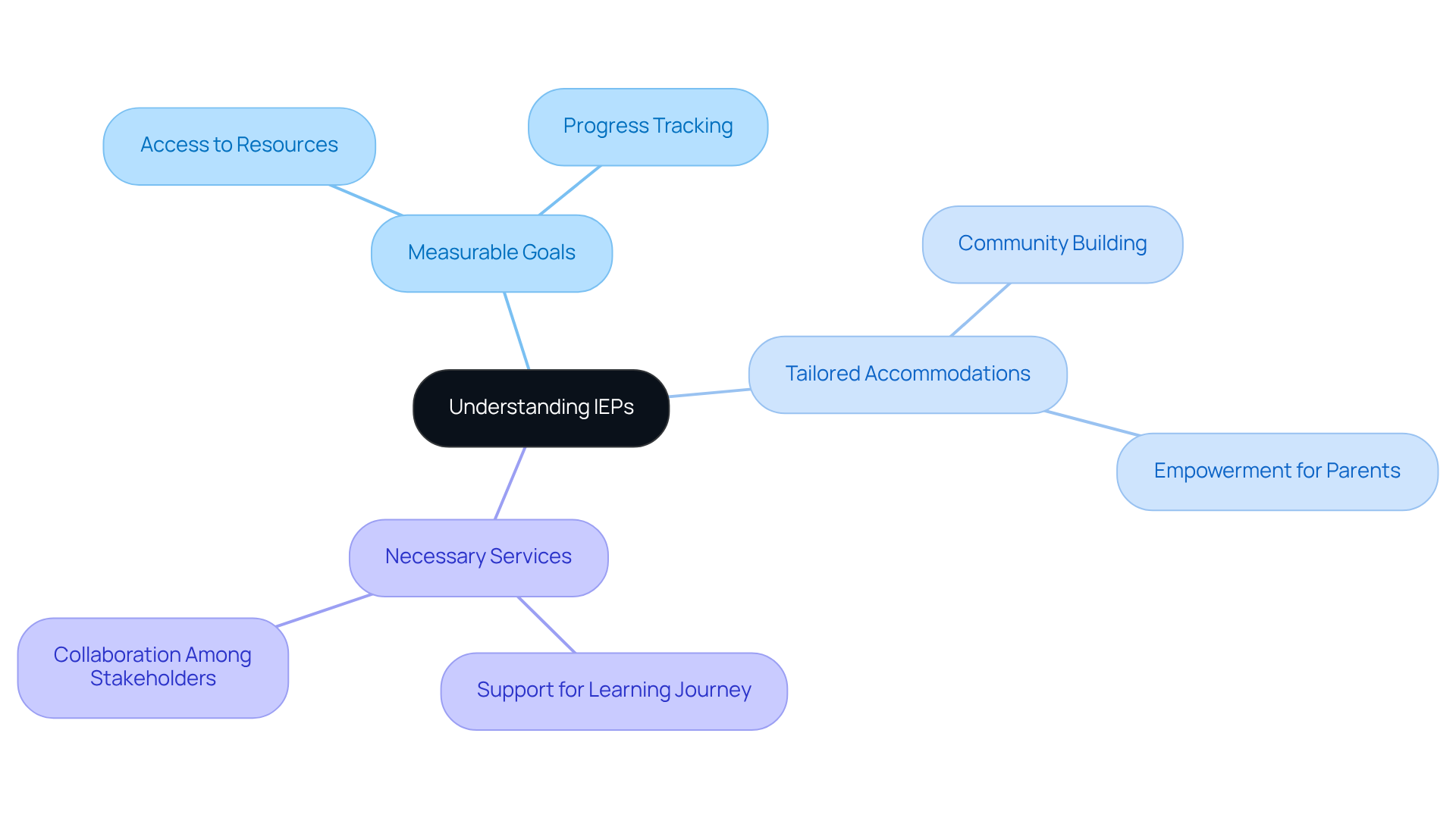
Mainstream vs. Special Education: Choosing the Right Environment for Your Child
Choosing the right educational environment for your child in autism special education is a pivotal decision that deserves your careful consideration. It's essential to reflect on their unique needs, strengths, and challenges. Mainstream schooling can offer wonderful opportunities for social integration and interaction with diverse peers, enhancing social skills and nurturing friendships. On the other hand, autism special education provides customized support, specialized resources, and a structured environment tailored to individual learning styles.
As you assess your options, consider key factors such as your child's social skills, sensory sensitivities, and academic requirements. For instance, children with sensory processing disorder may benefit significantly from the personalized attention found in specialized learning environments, where sensory breaks can be seamlessly integrated into their daily routines. Research shows that individuals with Sensory Processing Disorder thrive when they have sensory breaks throughout the day to help maintain their regulation.
Additionally, understanding current enrollment rates can be enlightening. Approximately 7.3 million disabled students in the U.S. represented 15% of national public school enrollment during the 2021-22 school year. This statistic underscores the importance of tailored programs in autism special education that meet diverse needs.
Successful transitions from autism special education to mainstream education often hinge on effective advocacy by parents. By ensuring that the educational plan aligns with your child's learning potential, you can help pave the way for their success. As one supporter wisely states, "Continue to be your offspring’s biggest and best fan (advocate)!" Ultimately, your decision should prioritize your child's well-being, fostering an environment where they can thrive both academically and socially.
Connecting with other parents and joining support groups can provide invaluable insights and encouragement throughout this journey. Sharing experiences can create a sense of community and support, reminding you that you are not alone in this process.
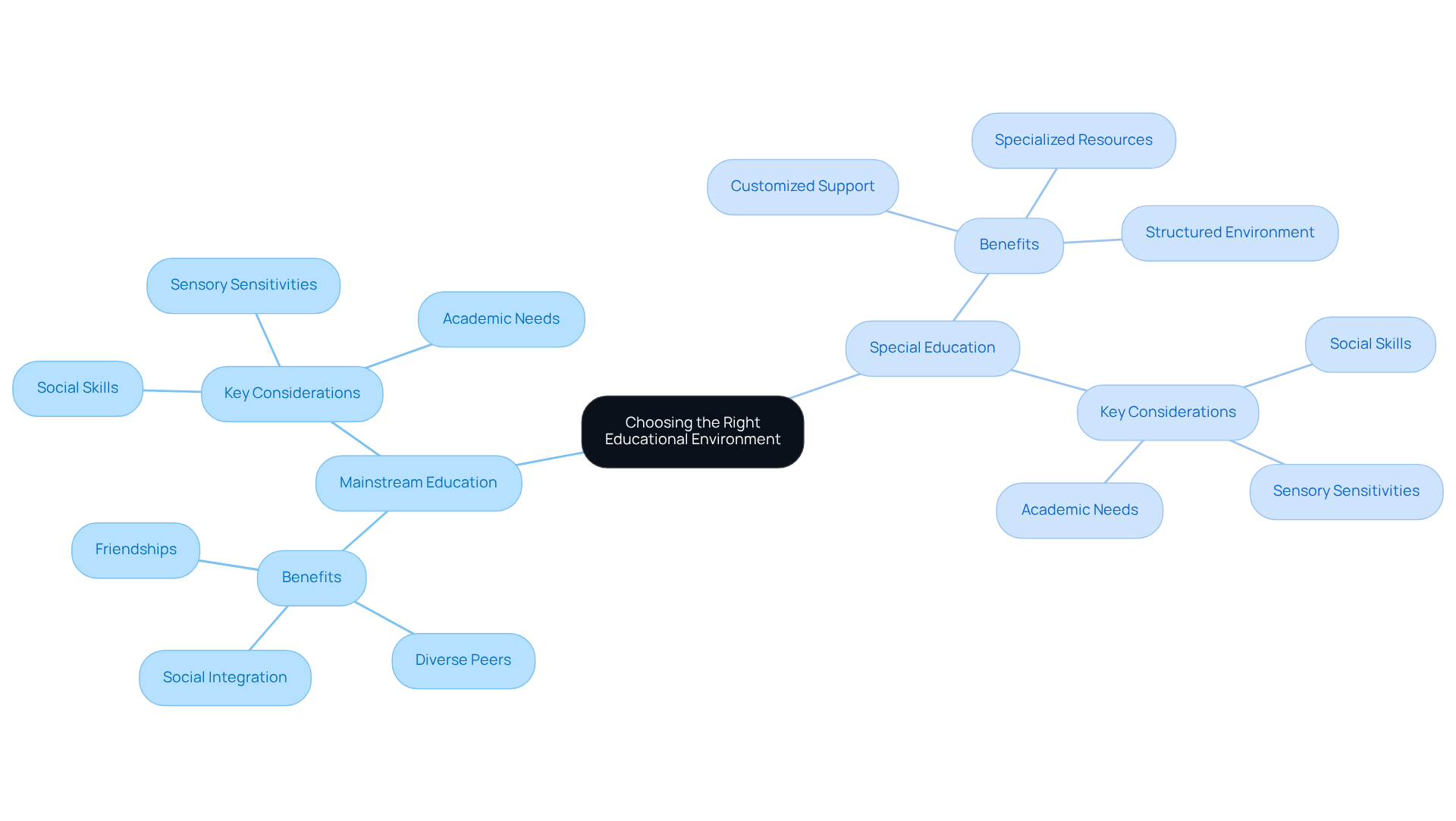
The Importance of Early Diagnosis: Enhancing Outcomes for Children with Autism
Recognizing the signs of developmental conditions early is crucial for fostering better outcomes for our children. Research indicates that children diagnosed before the age of three often benefit significantly from early intervention services, leading to meaningful improvements in their communication, social skills, and overall functioning. As parents, it's essential to stay vigilant about developmental milestones and to seek professional assessments if you have any concerns about your child's progress. Taking these steps can lay the groundwork for lifelong success and well-being.
By prioritizing early identification, you not only advocate for your child's needs but also open the door to resources and support that can make a real difference. Remember, you are not alone in this journey. Many parents share similar experiences and challenges, and together, we can create a community of understanding and encouragement. If you suspect your child may be on the spectrum, don't hesitate to seek guidance and support for autism special education. Early intervention can truly be transformative.
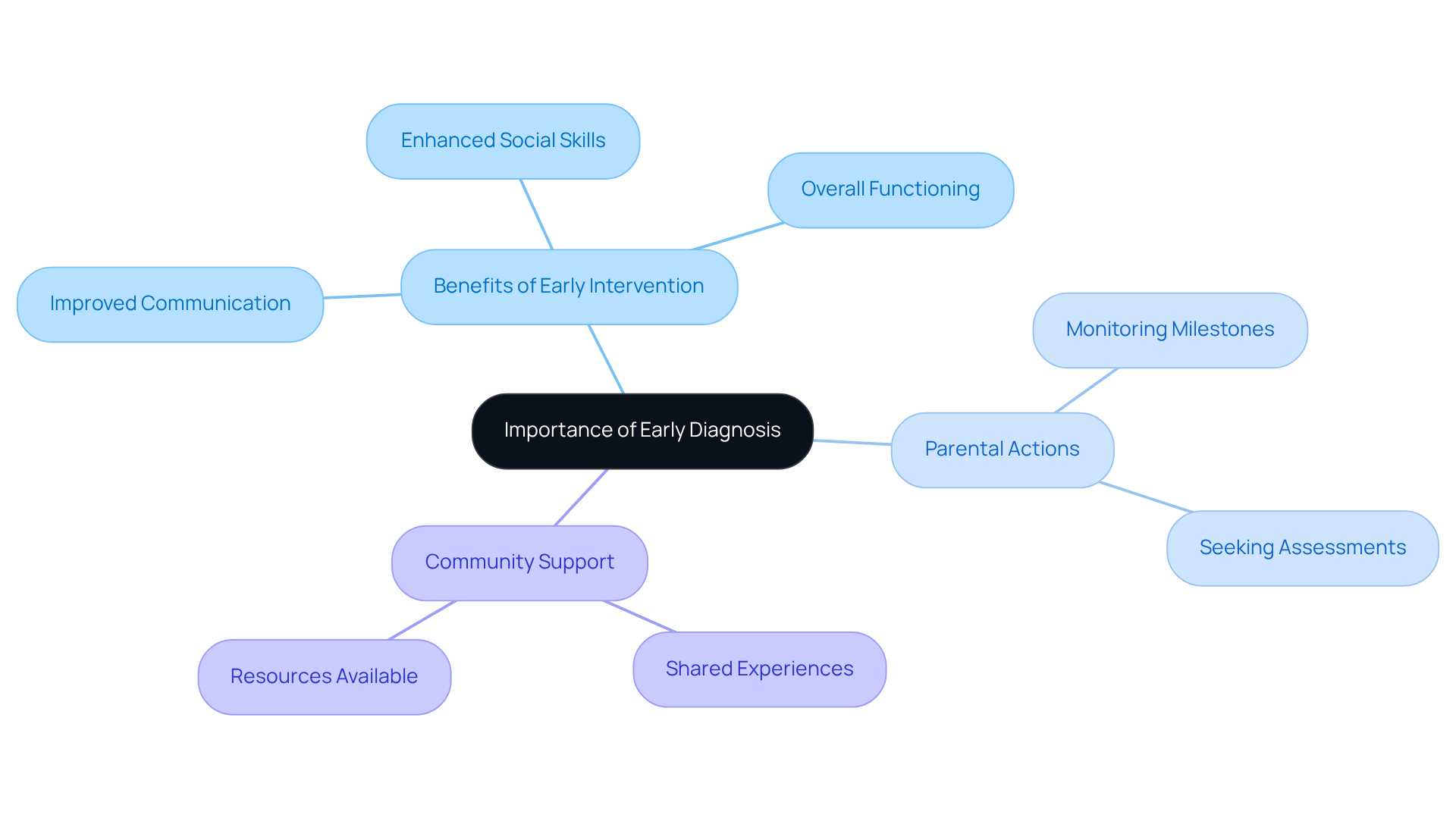
Effective Communication: Bridging the Gap Between Parents and Educators
Effective communication between guardians and educators is vital for supporting youth in autism special education. When we create open channels of communication, guardians can share valuable insights about their child's strengths and challenges, fostering a collaborative environment. Regular meetings, progress updates, and sharing positive observations not only enhance the educational experience but also promote shared goal-setting, which is essential for effective outcomes.
Using visual aids and employing clear, concise language can significantly improve understanding and collaboration between caregivers and educators. For instance, incorporating strategies such as summarizing caregivers' statements confirms understanding and demonstrates active listening—key elements in building trust. Additionally, honoring various family configurations and backgrounds, including ensuring that printed materials represent diverse households such as those with same-sex caregivers, guarantees that communication is inclusive and effective.
Research suggests that effective communication strategies lead to improved engagement and collaboration, ultimately enhancing educational outcomes for children with autism special education. By emphasizing respectful conversation, utilizing preferred pronouns, and engaging in active listening, educators can cultivate a supportive environment that empowers guardians and enhances collaborations in autism special education. Moreover, working with interpreters when language barriers exist is crucial for fostering effective communication with all families.
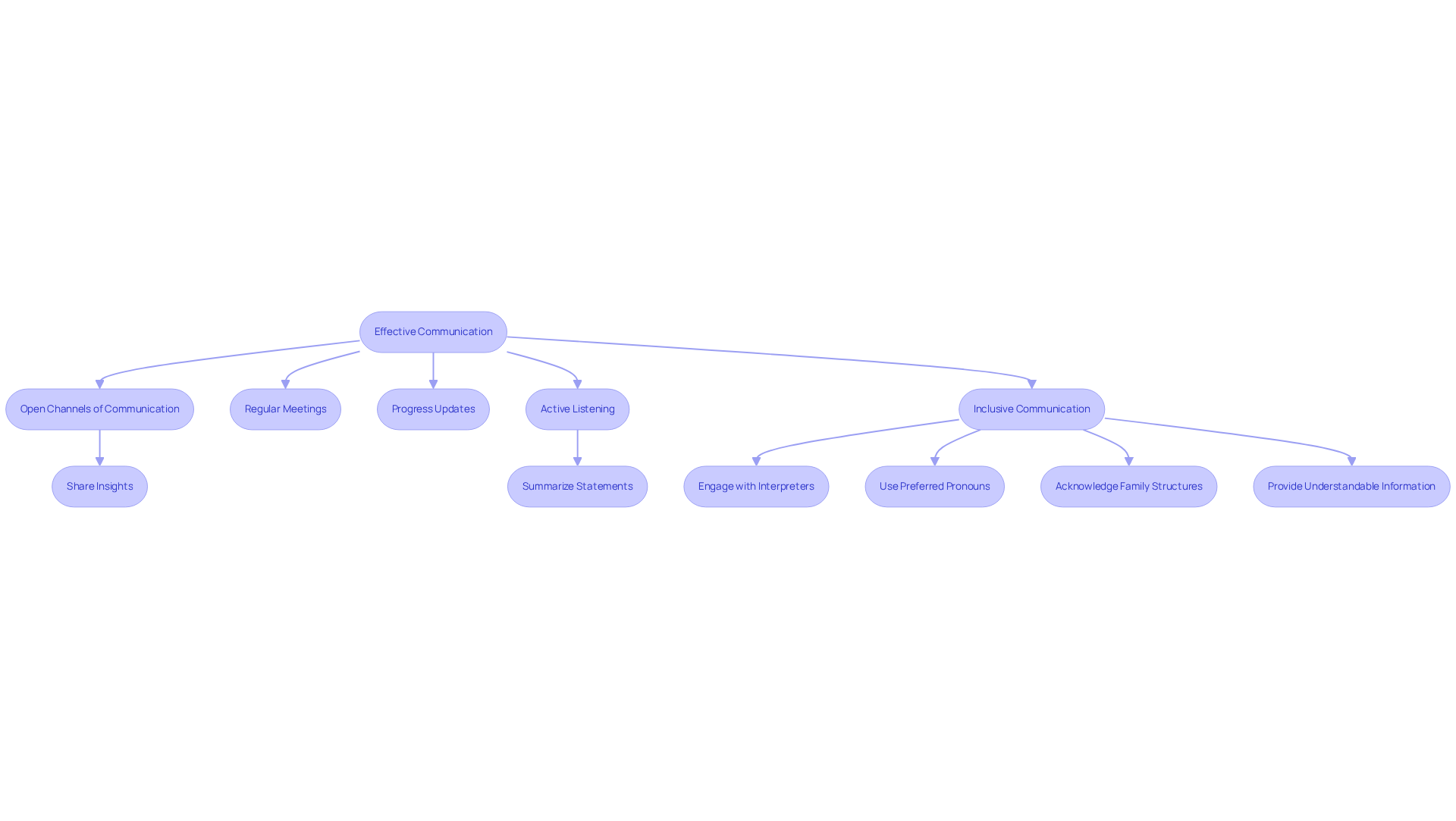
Exploring Support Services: Navigating Resources for Autism Education
Navigating the landscape of support services for individuals with developmental disorders, particularly in autism special education, can feel overwhelming for parents. It’s essential to know that vital resources are available, including autism special education services and therapy options like Applied Behavior Analysis (ABA), which is recognized for its effectiveness in addressing challenging behaviors. Parents are encouraged to explore both local and national organizations that offer guidance, funding assistance, and educational materials tailored to their unique needs.
Early diagnosis and intervention are critical in autism special education, as they can significantly enhance the effectiveness of support services. By creating a strong support network, families not only gain invaluable resources but also foster connections that can improve their journey. Participating in community support groups can provide shared experiences and insights, making the path to effective autism special education for individuals on the spectrum more manageable and empowering.
ASD Media plays a vital role in this landscape by fostering collaboration and growth within the ABA therapy industry. This ensures that parents have access to the best resources available. Remember, you are not alone in this journey—reach out, connect, and explore the support that can make a difference in your family's life.
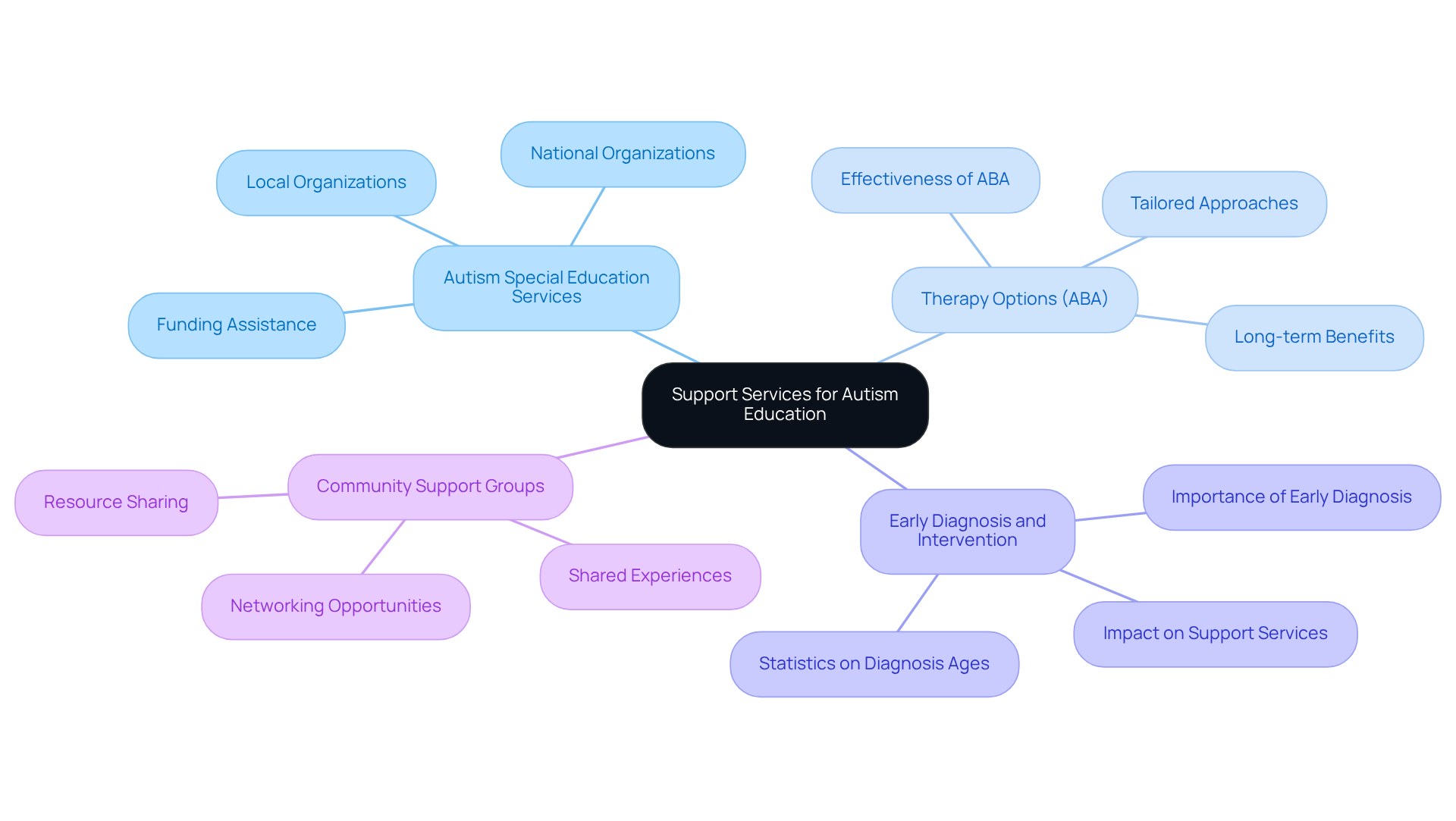
Behavioral Strategies: Tools for Managing Autism Challenges in Education
Implementing effective behavioral strategies is essential for addressing challenges in the classroom and fostering an inclusive environment for individuals with autism. Techniques such as positive reinforcement, visual schedules, and structured routines have been shown to enhance both learning and emotional regulation. Prompt intervention plays a critical role in achieving positive outcomes for youth with Autism Spectrum Disorder (ASD). Research indicates that individuals participating in early intervention programs experience a remarkable 60% decrease in challenging behaviors within just six months.
As educators, it is vital to prioritize understanding the triggers behind challenging behaviors. This understanding allows for the creation of tailored behavior intervention plans that cater to each child's unique needs. Consistency in applying these strategies, paired with strong collaboration between parents and teachers, is crucial for achieving successful outcomes. In fact, more than 80% of families report an enhanced quality of life and reduced stress levels after engaging in early intervention programs. This underscores the importance of a collaborative approach in supporting individuals on the spectrum.
As Ralph Moller wisely states, "When it comes to therapy for individuals on the spectrum, one size does not fit all." This highlights the necessity for individualized strategies that truly resonate with each child's circumstances. By working together and sharing experiences, we can create a nurturing environment that promotes growth and understanding for all.
Advocacy in Special Education: Empowering Parents to Make a Difference
Advocacy plays a vital role in navigating the complexities of autism special education for individuals on the autism spectrum. It’s essential for parents to fully understand their rights under the Individuals with Disabilities Education Act (IDEA) and to take an active role in Individualized Education Program (IEP) meetings. Building strong relationships with educators and professionals can significantly enhance advocacy efforts. By voicing their concerns and specific needs, parents can secure the crucial support and resources necessary for their child's academic and social success.
Recent trends show a growing acknowledgment of the importance of parental involvement. Many schools are now adopting strategies to improve communication and collaboration with families. It’s worth noting that 15% of students served under IDEA also have other health impairments, which underscores the diverse needs among students with disabilities. Effective advocacy not only improves educational outcomes in autism special education but also fosters a nurturing environment where individuals can thrive. As a poignant reminder, "Continue to advocate and believe in your child."
Moreover, numerous schools have initiated anti-bullying programs to maintain a positive atmosphere, further supporting parents in their advocacy efforts. ASD Media provides valuable strategies for managing challenging behaviors and navigating support services, offering practical resources that empower caregivers to enhance their advocacy. Together, these efforts create a supportive community that encourages every child to reach their full potential.
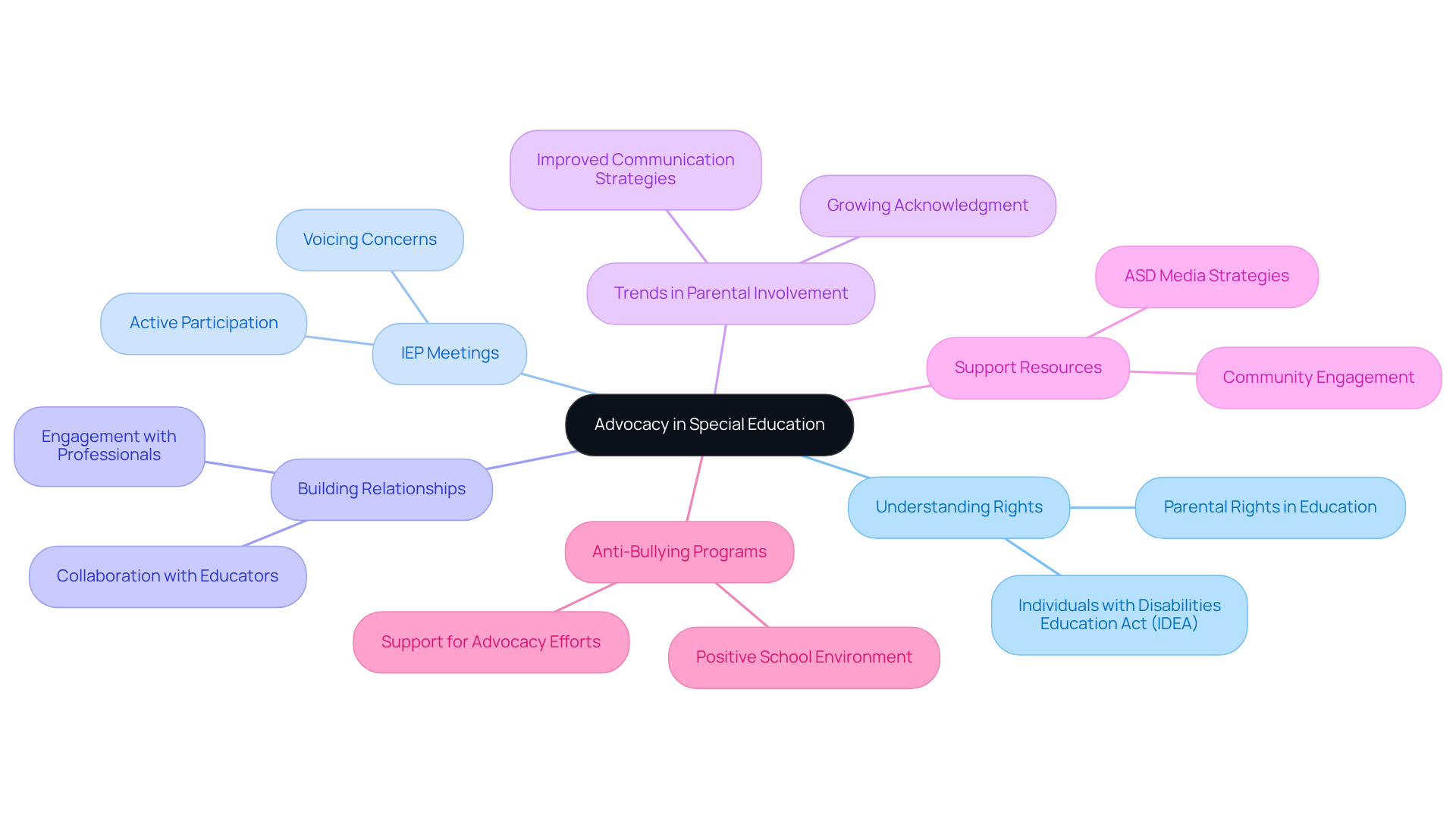
Collaboration for Success: Working Together in Autism Education
Cooperation among parents, educators, and therapists is essential for the success of children with developmental disorders. By creating a team approach, we ensure that everyone involved in the child's learning is unified in their objectives and methods. This unity is increasingly vital, especially given the rising number of students with autism—currently 1 in 22 four-year-olds in California. Such statistics highlight the urgent need for effective teamwork in educational settings.
Regular communication and shared decision-making can significantly enhance the effectiveness of interventions. For instance, the California Autism Professional Training Network promotes 27 evidence-based practices, such as visual supports and reinforcement, which are crucial for managing classroom behavior. When families and professionals work together, they can create a nurturing environment that fosters growth and learning, ultimately leading to improved educational outcomes.
Successful team approaches have been shown to address challenges like emotional dysregulation and sensory issues, which are increasingly common in students with autism. Recent studies emphasize the importance of collaboration, particularly in special needs contexts where various requirements must be met through coordinated efforts. As Jenine Catudio, a specialist for students with mild-moderate needs, points out, 'Collaboration among educators, support providers, and families is essential, particularly for families from low-income backgrounds who may lack resources.' This collaboration not only benefits the individual learner but also contributes to a more inclusive educational environment for all students.
However, we must acknowledge the challenges faced by educators and families, such as underfunding and teacher shortages, which can hinder effective collaboration. Ongoing professional development and training for educators are crucial to equip all stakeholders with the necessary skills for effective teamwork. Together, by prioritizing collaboration, we can create a brighter future for our children.
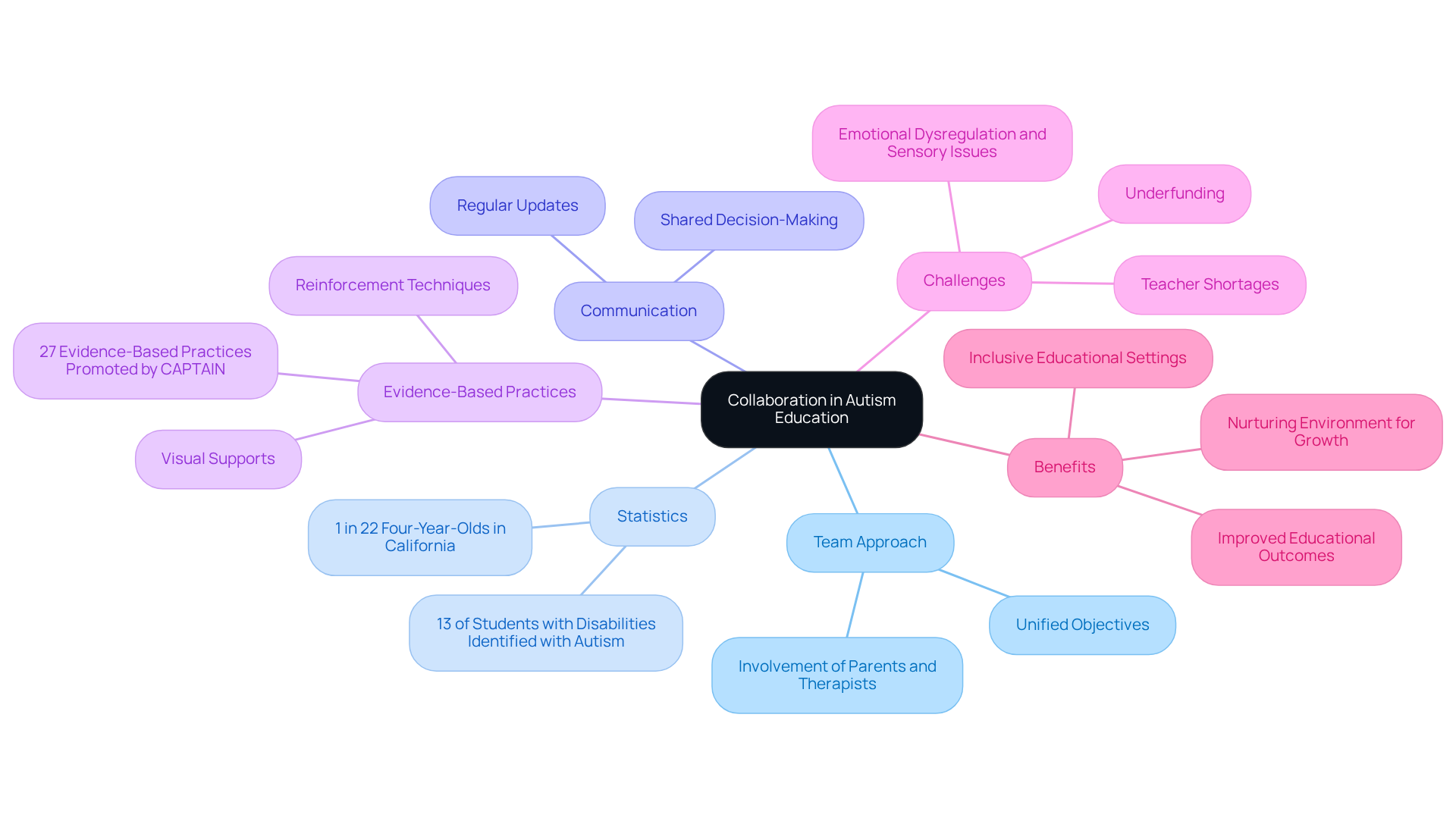
Continuous Learning: Staying Informed About Autism Special Education
Ongoing learning is essential for both parents and professionals who support individuals with developmental differences. Staying informed about the latest research, strategies, and resources can significantly enhance the assistance provided to children with developmental disorders. Parents are encouraged to explore workshops, webinars, and literature focused on developmental disorders to deepen their understanding. Engaging with the neurodiverse community through forums and support groups not only fosters connections but also offers invaluable insights and shared experiences.
While it is heartening that 74% of autistic students in the U.S. graduate with a diploma, it is crucial to recognize that 8% of autistic students do not finish high school, compared to 5% of all students. This disparity highlights the unique challenges faced by these students. As the occurrence of developmental disorders continues to rise, with the CDC reporting that 1 in 31 young individuals in the U.S. is affected, the need for knowledgeable advocacy and effective strategies becomes even more pressing.
By actively participating in professional development opportunities, such as targeted workshops and webinars, educators can stay updated on current trends and best practices, ultimately enriching the educational experience for children with autism. Understanding that the average age of diagnosis in the U.S. is 5 years further underscores the importance of early intervention and timely support. Collaborating with autistic individuals in research can also contribute to creating effective practice guidelines, ensuring that the educational strategies employed are genuinely beneficial.
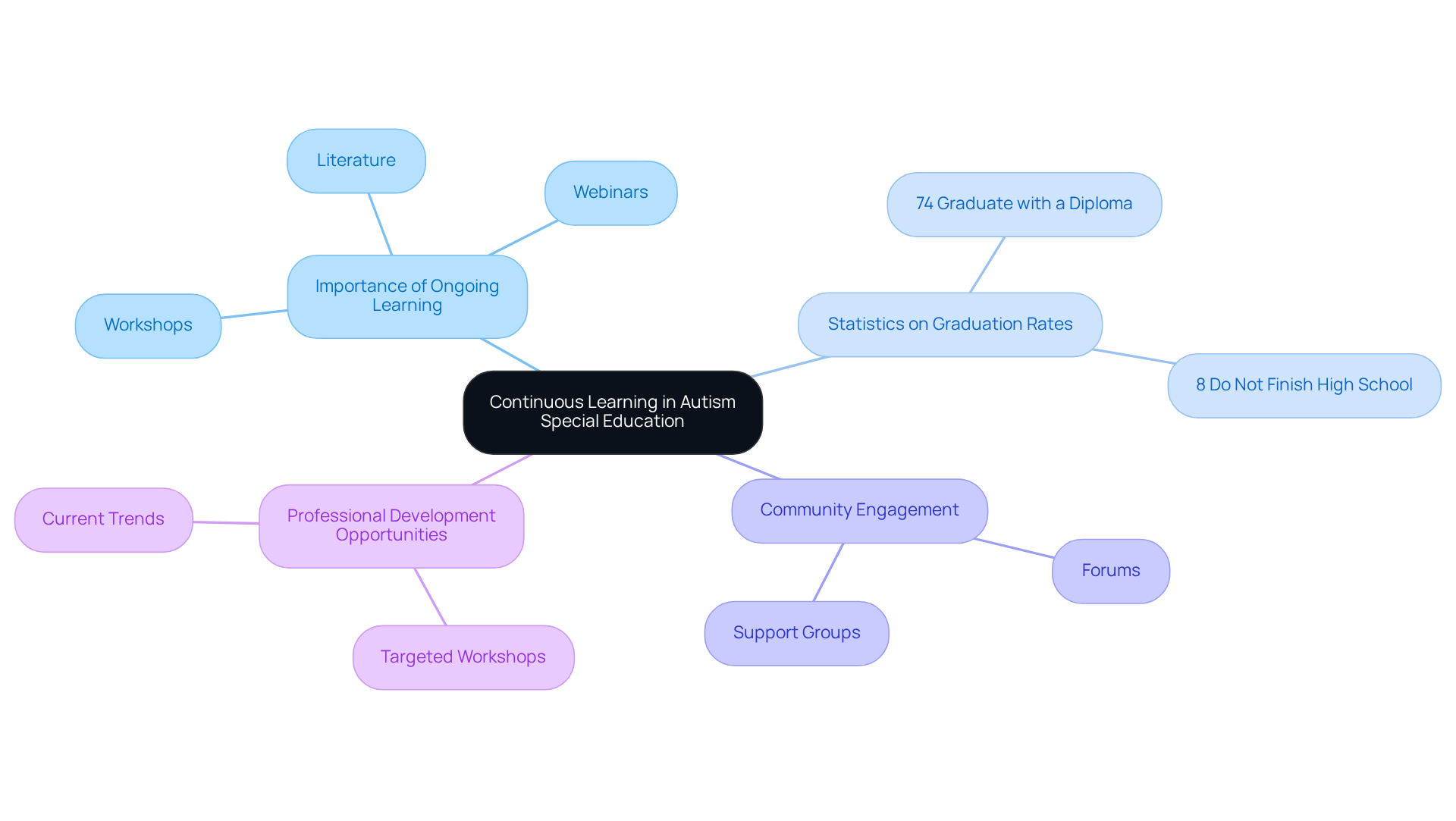
Conclusion
Understanding autism special education is essential for creating an inclusive and effective learning environment for children on the spectrum. The insights shared in this article highlight the importance of collaboration among parents, educators, and specialists. A united approach can significantly enhance educational outcomes. By focusing on individualized strategies, effective communication, and the value of early intervention, stakeholders can work together to unlock the full potential of every child.
Key arguments throughout the article underscore the necessity of tailored educational plans like IEPs, the need for early diagnosis, and the benefits of selecting the right educational environment. Moreover, the importance of ongoing advocacy and continuous learning cannot be overstated. These elements empower families and educators to navigate the complexities of autism education effectively. Each insight serves as a building block toward creating a supportive framework that prioritizes the unique needs of children with autism.
Ultimately, the journey in autism special education requires commitment, understanding, and community support. By actively engaging with available resources, participating in advocacy efforts, and fostering open communication, parents and educators can create a nurturing environment that encourages growth and success. Embracing these essential insights not only enhances the educational landscape for families but also ensures that every child has the opportunity to thrive and reach their full potential.
Frequently Asked Questions
What is ASD Media and its mission?
ASD Media is dedicated to enhancing the implementation of Applied Behavior Analysis (ABA) therapy by providing valuable insights and strategies to help overcome challenges and improve outcomes for children with autism and their families.
What resources does ASD Media offer to parents and specialists?
ASD Media offers a diverse array of resources tailored for caregivers and specialists in the developmental support sector, including strategies for managing challenging behaviors, navigating support services, and enhancing social skills development.
How does community support impact autism special education?
Research indicates that community support significantly influences outcomes in autism special education. Collaborative efforts lead to better access to resources and services, with studies showing positive trends in patient goals after implementing community-driven initiatives.
What are Individualized Education Programs (IEPs)?
IEPs are specially crafted educational plans that cater to the unique needs of students with autism, including measurable goals, tailored accommodations, and necessary services to support each student's learning journey.
What are the benefits of IEPs for children with autism?
IEPs ensure access to appropriate educational resources, foster a sense of community among stakeholders, and provide a structured framework for tracking progress, empowering parents to advocate effectively for their child's educational needs.
How do IEPs support advocacy for a child's educational needs?
Understanding IEPs empowers parents to advocate effectively for their child's needs, which is crucial for achieving successful outcomes in both academic and social development.
What should parents consider when choosing between mainstream and special education for their child?
Parents should reflect on their child's unique needs, strengths, and challenges, considering factors like social skills, sensory sensitivities, and academic requirements to determine the most suitable educational environment.
What are some advantages of mainstream schooling for children with autism?
Mainstream schooling offers opportunities for social integration and interaction with diverse peers, which can enhance social skills and nurture friendships.
What are the benefits of autism special education?
Autism special education provides customized support, specialized resources, and a structured environment tailored to individual learning styles, which can be particularly beneficial for children with sensory processing disorders.
How can parents effectively advocate for their child's transition from special education to mainstream education?
Successful transitions often rely on effective advocacy by parents to ensure that the educational plan aligns with the child’s learning potential, thus paving the way for their success.
How can connecting with other parents be beneficial during this journey?
Connecting with other parents and joining support groups can provide invaluable insights and encouragement, fostering a sense of community and support throughout the educational journey.




